WHEN IT’S MORNING IN KAMCHATKA, THE REST OF RUSSIA IS STILL ASLEEP. KAMCHATKA IS DIFFERENT IN EVERY WAY. THE LOCALS CONSIDER POISONOUS HOGWEED SWEET, ASIANS PRETEND TO BE AMERICANS, THE POLICE CHASE BEARS, AND RESIDENTS PREFER FLYING TO BUILDING NEW ROADS
TEXT: GRIGORI KUBATYAN
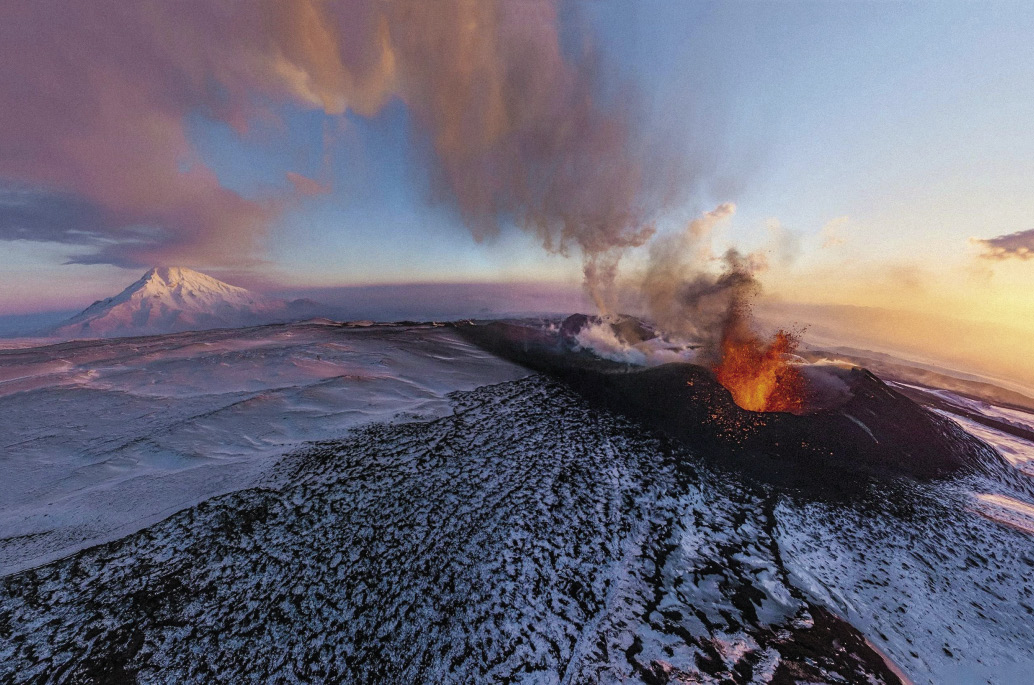
Aroaring KAMAZ truck struggles across massive potholes. Branches lash against the windows. The seats in the cabin are equipped with seat belts, and you’d better fasten them — otherwise you could go flying. We had a flat tyre on our way, but, fortunately, the driver of the KAMAZ behind us stopped to help us change it.
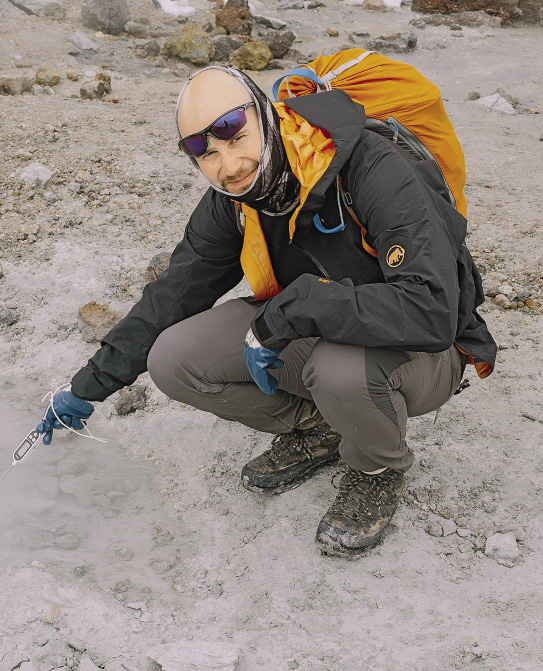
Why Do We Need Roads?
Kamchatka trucks drive in pairs, afraid to remain bogged down in the mud if something breaks. While helping each other is a tradition, truck drivers and jeep drivers belong to different clans… between which little love is lost. Jeep owners drive their customized monster machines without license plates, and their gigantic wheels cause havoc with tracks, which can lead to KAMAZ trucks getting stuck. If a truck driver sees a jeep stuck in the mud, there is a good chance that they will just pass by — “let them make their own way back to town, it’s too far to tow them all the way.” Ahead rivers, mud, and lava lie across their path.

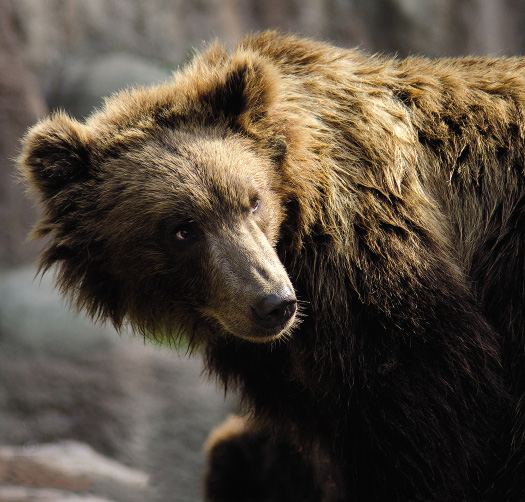
We are driving through the Volcanoes of Kamchatka National Park. Travelling around Russia can be a pitiless experience, but it is far from pointless. While local natural sites are breath-taking, the roads will require all your courage. If in doubt, choose a helicopter trip at $530 (RUB 40,000) per hour, though be warned that one hour will not be enough.
Some people believe that Kamchatka should welcome only wealthy travellers for helicopter trips with an average trip price of $1,300 (RUB 100,000) or higher, rather than thrifty backpackers. It would certainly remove the need for building more roads!
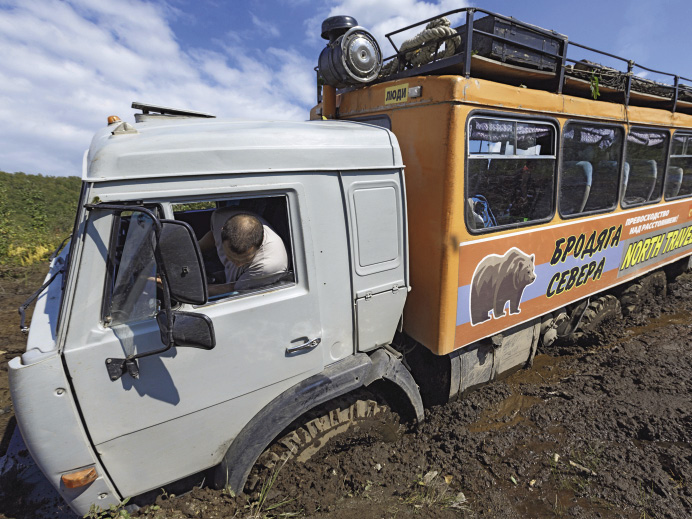
Everything in Kamchatka matches its epic size, including oversized car wheels and the shoe-sized pirozhki (stuffed pastries) served in roadside cafes. Giant burdocks and hogweeds tower by the road side. Puchka (windy) is the local name for hogweeds, which was used by the pioneering Cossack settlers for distilling moonshine vodka, which gave drinkers wind. Reportedly, in the past the people of Kamchatka used to grow head-sized turnips. On the other hand, there is very little livestock to be seen in Kamchatka, and it has one of the lowest populations of cows and pigs in the country – despite the almost limitless potential source of feed!
KAMCHATKA TRUCKS OFTEN DRIVE IN PAIRS,
AFRAID TO REMAIN BOGGED DOWN IN THE
MUD IF SOMETHING BREAKS. HELPING EACH
OTHER IS A CUSTOM HERE.
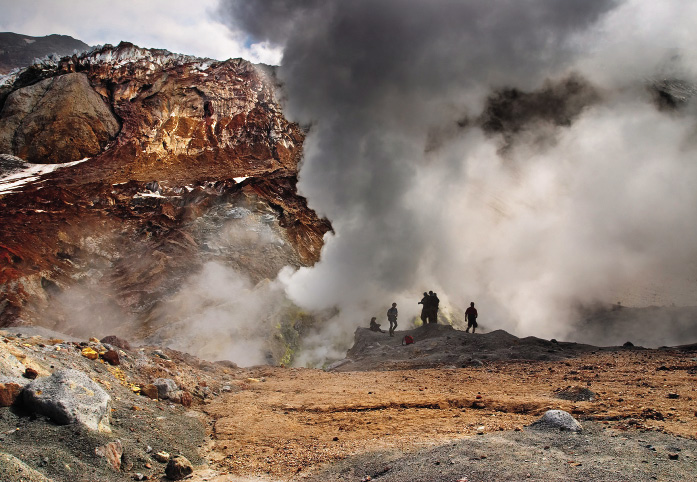
Jean-François de Lapérouse, a French explorer, wrote about his trip to Kamchatka back in the 18th century: “Natural meadow grass grows up to 4 feet (1.2 meters). It would be possible to stack enormous amount of hay for winter, which lasts seven to eight months in this climate. But the people of Kamchatka find this idea too troublesome, as it would require large weather-resistant hay-lofts and barns. They prefer to live by hunting and fishing, in particular, salmon, which is a godsend to their rivers, arriving like manna from heaven annually to fill their fishing nets and provide food for the whole year.”

Nothing has changed in the two centuries since. The few cattle breeders face a formidable challenge in delivering milk and meat to buyers along local roads.
See a Bear and Live to Tell the Tale
Although there are certainly lots of bears in Kamchatka, illegal fishing is stripping local rivers of spawning fish. Bears can no longer catch enough fish to accumulate sufficient fat to sleep through the winter. Hunger wakes them up in mid-winter and they cannot get back to sleep. There is no food in winter, so insomniac bears turn to people in search of something to eat. At the end of summer and in autumn, however, there are still plenty of fish and berries. If you hear a rustling in the bushes, it may well be a bear — but they rarely attack humans.
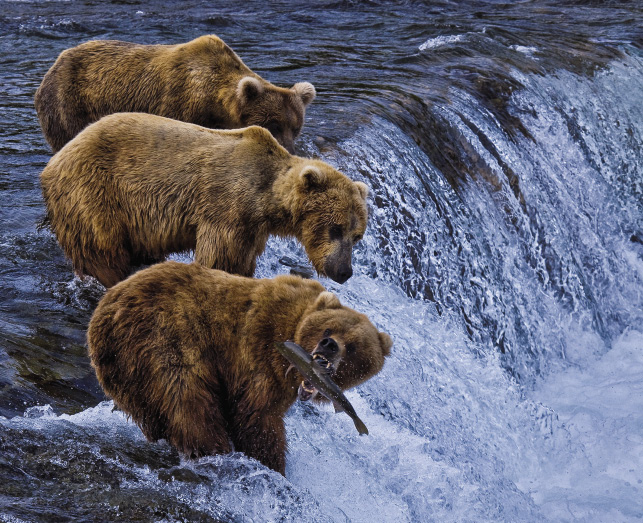
Our guide is Alexander, a 59-year-old ex-gamekeeper who is now an educator and tour guide.
“The bear is a strong, but very timid, animal. If you see it, just shout loudly and put up your hands up to look taller,” he says. “But if you run, you’re in trouble, because it will follow and catch you.”
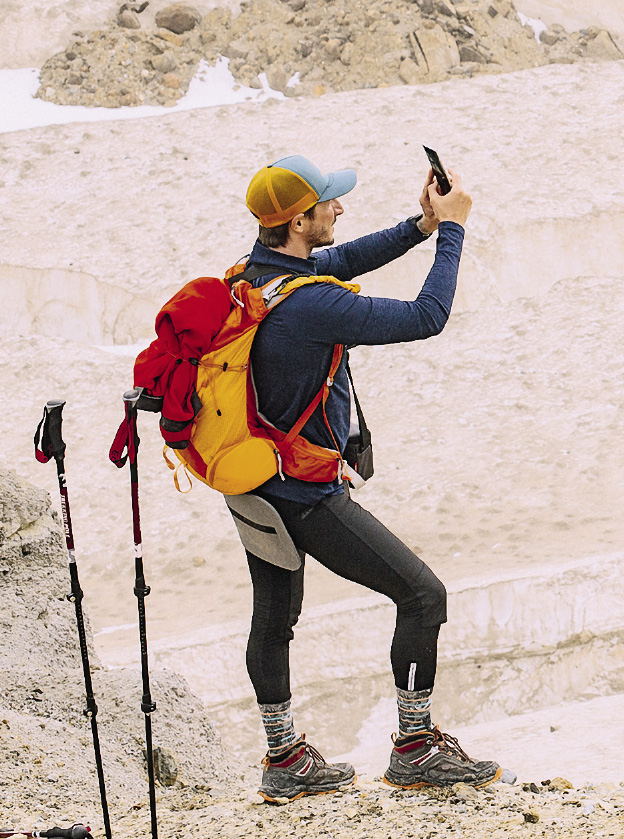
We saw a large bear poking around at the side of the road from our bus. We stopped and rushed out, but didn’t get too close. It was huge. I’d like to see someone try and scare a bear like that!
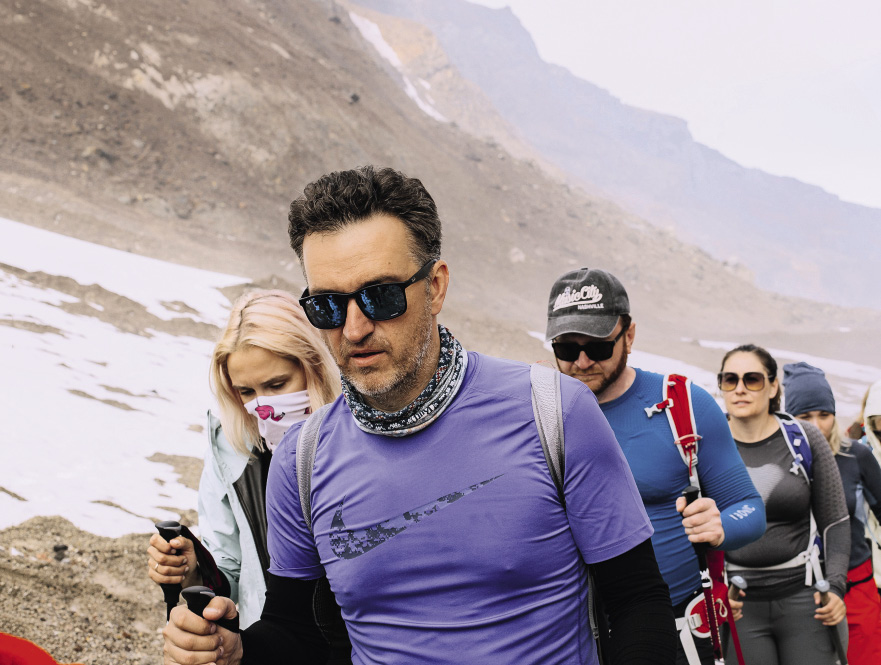
We saw another one walking along a glacier. Why? There is no food for it up in the mountains. Perhaps it was just enjoying the view?
“Oh, that’s all kid’s stuff. Sometimes bears take a walk in the city. Last year, a bear with cubs took a stroll in Yelizarovo,” Alexander said. “The police drove them off with sirens. And not long ago we had a forest warden eaten by bears. He found a dead bear and wanted to take out its teeth and nails as a souvenir. But this bear had been dead for quite a while, and other bears were already eating it. So, they came and saw this forest warden… And ate him too.”
ILLEGAL FISHING STRIPS LOCAL RIVERS OF SPAWNING FISH. BEARS CAN NO LONGER CATCH
ENOUGH FISH TO ACCUMULATE SUFFICIENT FAT TO SLEEP THROUGH THE WINTER.
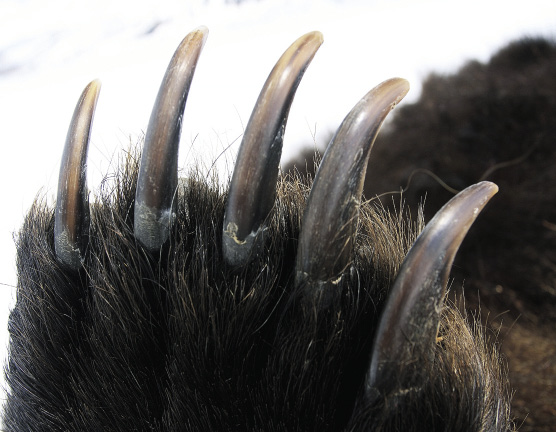
Alexander recalled his first experiences as a tour guide in the early 1990s. Kamchatka had just been opened for foreign travellers and some Dutch tourists came to take pictures and enjoy the sites. They also left some feedback, wondering why we had such weird footpaths in the forest, with branches hanging low overhead and forcing people to stoop down the whole way.

“Well, we didn’t make those paths, the bears did!” Alexander says. “Bears walk on all-fours and don’t care about low-hanging branches. Back then we made all our routes along bears’ pathways in the Siberian pine forest. Predictably, bears prefer to walk along rivers. They trample their paths so hard it looks as if a hundred people have passed by. We had no other pathways to offer at the time.”
Kamchatka’s Indians
Explorer Stepan Krasheninnikov recorded some interesting facts about Kamchatka’s indigenous people in the 18th century. Their favourite pastime was retelling and discussing their dreams. Seeing lice in a dream signified the Cossacks coming to collect tribute. To dream that you were vomiting meant that your relatives were coming to see you. To see sex meant that you would be lucky hunting or fishing. They also used to tell fortunes by shooting arrows from bows — the one whose arrow flew highest would live longest. Women also engaged in sports competitions, including wrestling with other amazons. The deceased were put in hollow logs which were then hung on trees, under which their belongings were laid out. People also used to strangle sacrificial deer with their bare hands. After adopting Christianity, nomads would carry their icons with them using specially blessed sacred deer, while they embroidered their clothes to drive away evil spirits.
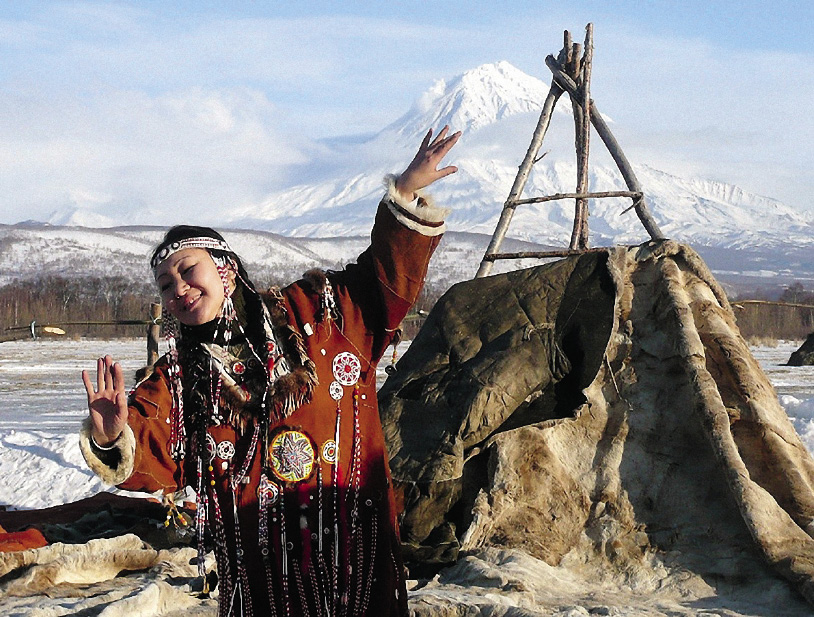
Our first stop was at the village of Esso. It houses a Koryak nomad camp Chau-Chiv, also known as the Andrianovka community. Alexandra Andrianova, the community host, welcomed us at the entrance gates. The community, which houses several houses and yurts (teepees), is a local museum.
Alexandra told us about the Koryaks in a huge super-yurt, recalling her childhood over fish soup and blueberries: “As a kid, I was taken away from my parents, put into a cold truck and brought to a boarding school. I hated it there.”
The Soviet government wanted to turn nomads into settled people and educate their children. The Koryaks and other nomads were unwilling to build communism. They lived in dugouts in unsanitary conditions and were illiterate, but seemed quite happy with their deer and fishing. They were loaded with favours against their will and were forced to live in villages and on collective deer-breeding farms. Now they are very much upset both with the Soviet Union and its collapse, because their collective farms have been terminated and their deer have been killed.
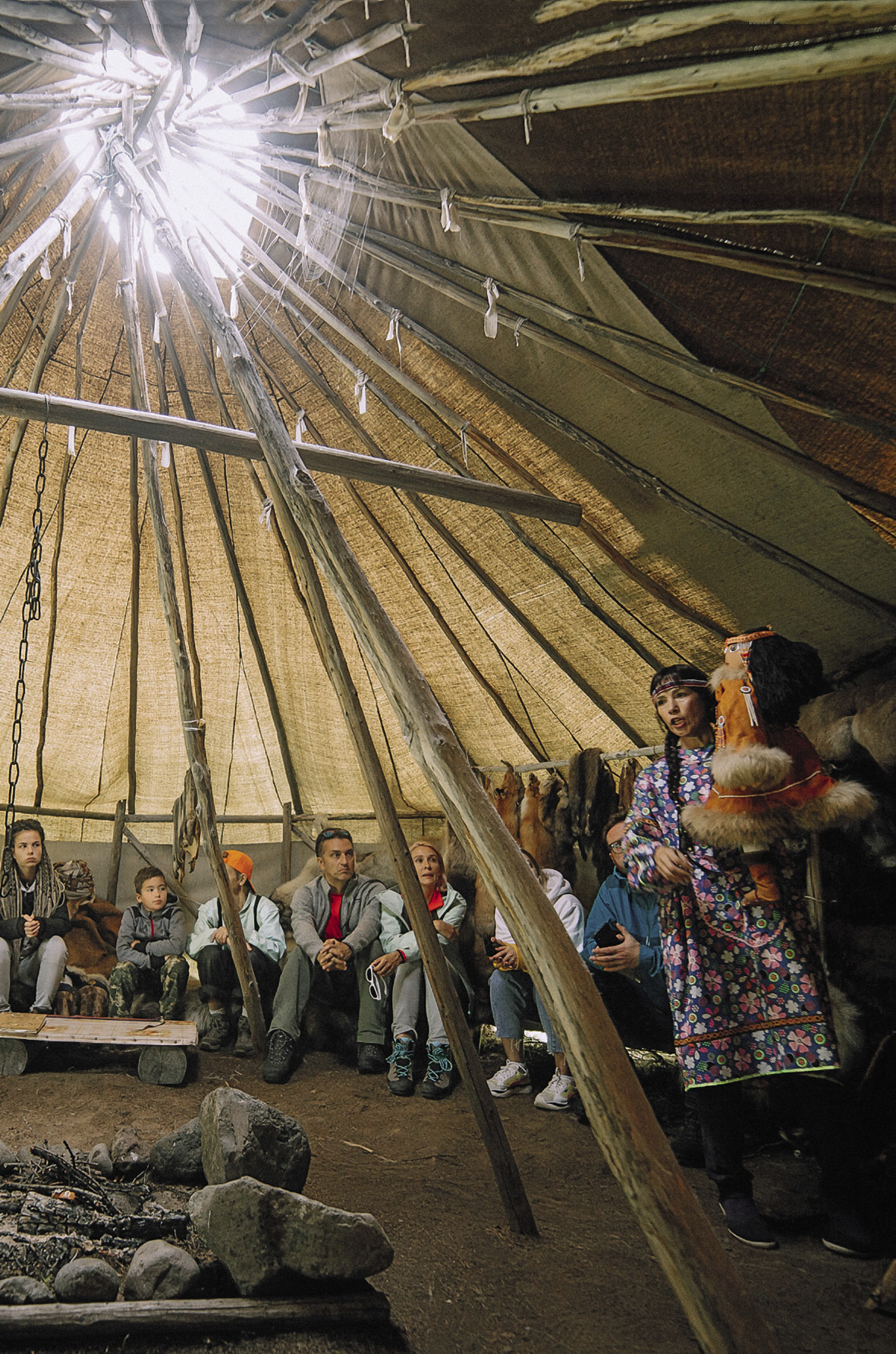
Nulgur, a well-known Even ethnic dance ensemble, came to the community to give a concert. It was a professional ethnic performance rather than an amateur talent show, and they have toured around the globe. The group includes not only Evens, but also Koryaks and Chukchi. Some dancers emulate the American Indians and wear bun hairstyles. In fact, if they swapped their drums for tomahawks, you might not be able to tell them apart.
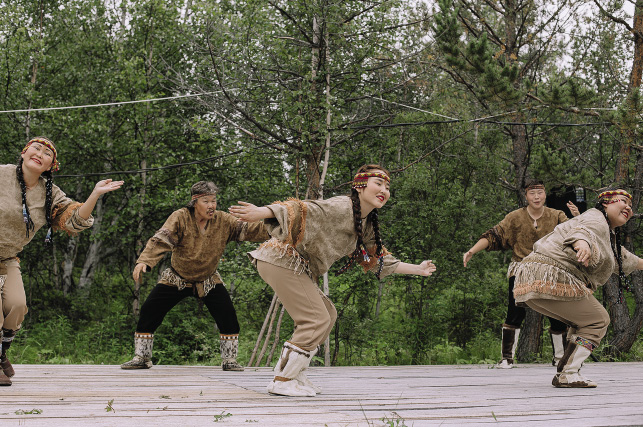
Kamchatka dances can seem frightening, vivid or erotic — it is a theatre show with lots of shouting and jumping. According to Jean-François de Lapérouse, “The dances of Kamchatka are comparable with the convulsions of the Convulsionnaires (a French religious sect) at the grave of de Pâris in Saint-Médard. They dance with their arms and shoulders, not using their feet. Their lamenting chesty shouts are the only music that sets the rhythm.”
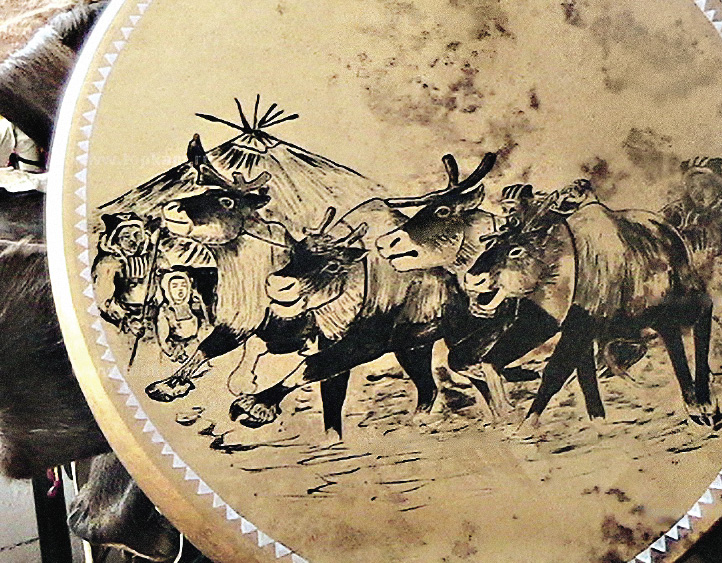
The wild jumps of this dance are a far cry from delicate French quadrilles, but they certainly have their own charm. It is an archaic round dance that gradually turns into a shamanistic ritual. You feel like jumping on stage and joining them in shouting and gyrating, and waving the tambourine’s drumstick in front of the round-faced women.
A 13-Kilometre-High Plume
The Koryaks are said to have shunned volcanoes, while the Evens sought to settle next to volcanoes because they loved to bathe in their hot water. The main thing was to feel the signs of the upcoming eruption and move the camp away in time. The Tolbachik volcano has erupted twice in the last fifty years. The 1976 eruption was so large that even astronauts saw it from space. The smoke plume rose
13 kilometres high and threw out 3 billion tons of hot stones.
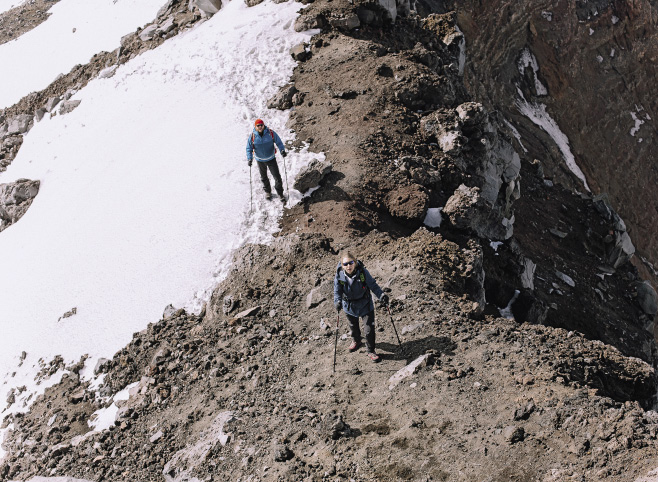
Researchers and journalists rushed to explore the event from all over the world, and the consensus was that it would be at least a century before the next eruption. However, the volcano erupted again in 2012 and destroyed some decrepit nearby buildings and the highway leading to the valley. The local government was waiting for federal aid to cut a new road through lava, but local activists decided not to wait, and have built their own road through the forest using only one bulldozer. Ten kilometres cost them RUB 150,000. This sum was raised by voluntary donations from around the world. Not strictly legal, of course, but the tourists need to get there somehow.

Tobachik is a tourist hotspot. It consists of two volcanoes: the extinct Ostry (3,682 m) and the active Plosky (3,140 m) volcanoes.
Tourists stay in Kleshnya camp, a.k.a. Rodnik. The former name refers to one of the volcano cones and the latter to a nearby well. The camp’s amenities are limited to a pair of tiny wooden toilet booths and a canteen. Development has progressed no further, and what has been built is regarded as unauthorised construction because the park’s executives haven’t been able to get approval for the required utility infrastructure for many years now. However, the camp hosts up to a hundred visitors on weekdays and faces constant challenges with KAMAZ and jeep parking on holidays and weekends.
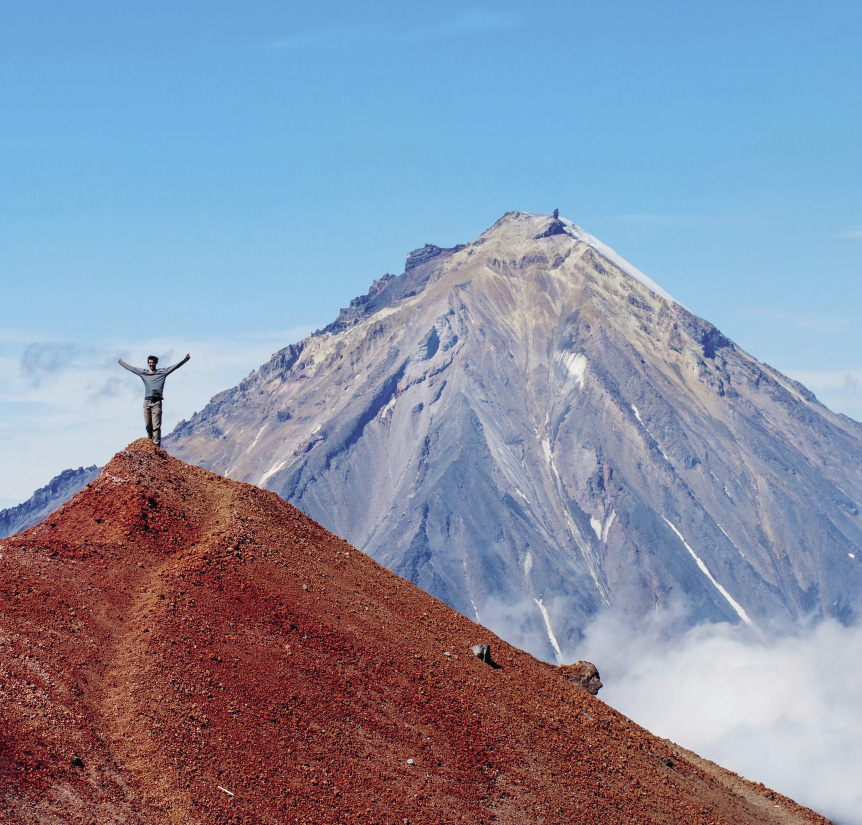
Anyway, there is enough black, cooled lava to go round. It is an endless sea of twisting, wrinkled stone. “Beneath, there are endless tunnels to explore and get lost in, with volcanic stalactites hanging from their ceilings.
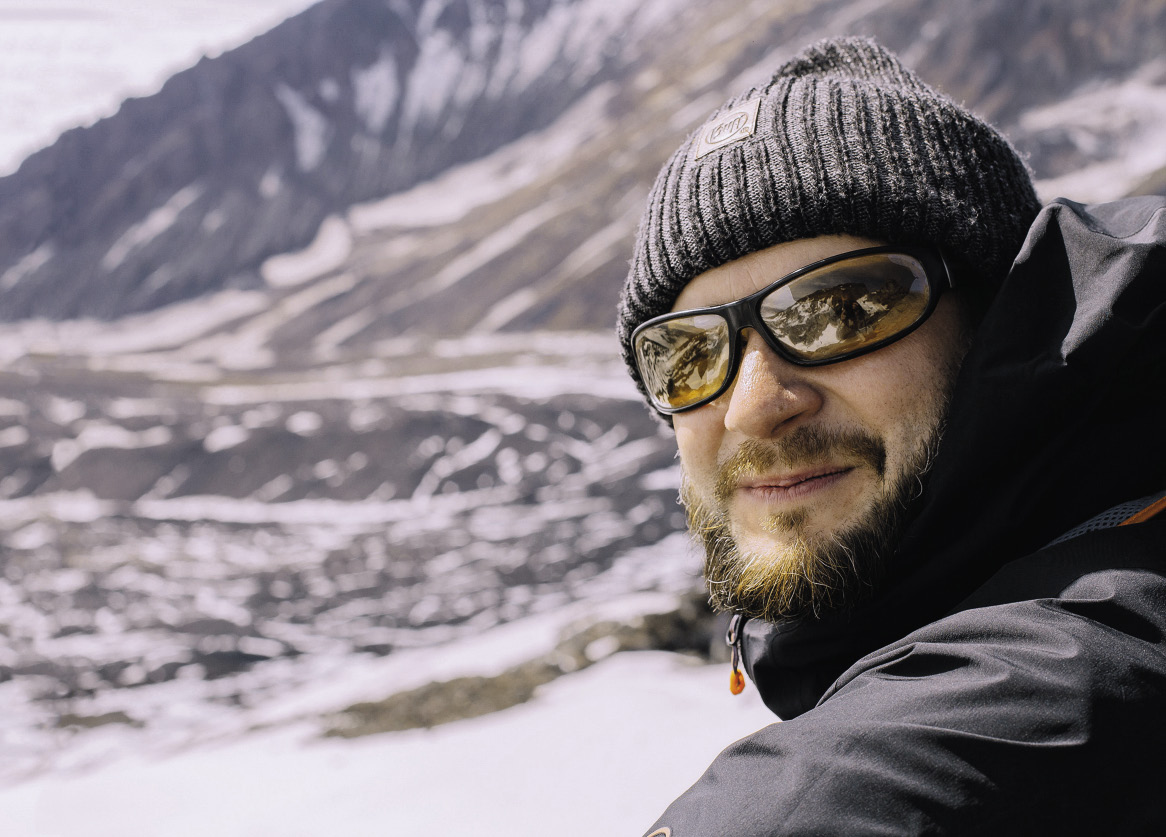
While it remains cold in the valley even in summer, the tunnels are hot like a sauna thanks to the heat from the active volcano. The park’s team has painted arrows to keep travellers from getting lost, especially when it’s foggy. In the absence of any signs or paths these arrows are a great help because it is easy to go off course and wander across the lava field for hours on end.
THE COOLED LAVA IS AN ENDLESS SEA OF
TWISTING, WRINKLED STONE WITH
TUNNELS UNDERNEATH IN WHICH IT’S
VERY EASY TO GET LOST
The Ascent
You can only see the odd helicopter hovering above the valley, because Tolbachik is beyond the range of ordinary helicopter routes. Most helicopters offer reasonable one- or two-hour flights around the environs of Petropavlovsk-Kamchatsky: to Gorely volcano, or to the smoking Mutnovsky volcano. But out here your only option is to walk.
The day before our ascent, my boots came apart. No wonder, if you take your old pair you haven’t worn in years rather than buy a new pair. The sole fell off, and with snow on the ground here even in August, forget about walking barefoot. The guide offered me gumboots, so my group-mates were wearing hiking boots but I had to make do with those and two pairs of woollen socks. It proved to be a godsend. On our route, we had to cross snow, streams, and waterfalls. My peers were jumping from stone to stone like wild mountain goats while I could stride through any obstacle. It turned out that gumboots are the best for climbing mountains.
Kamchatka’s summer feels more like a cold and foggy autumn. Climbing up above the clouds, you find yourself in a sunny and warm spring day with melting snow and running brooks. The winter with knee-deep snowdrifts comes a few kilometres up in the mountains.
It takes about eight hours to climb Tolbachik, although it depends on your fitness. Six hours would be enough for some travellers and others would be exhausted after two hours and turn back home. Tolbachik has a unique crater — or caldera, in academic terms — which is 1.8 kilometres wide and 400 metres deep. It’s large enough to fit a small village.
The slopes overlook volcanic cones in the valley, the snow-covered summits of the Klyuchevsky volcanic group, and the cloud cover far below. The only other view which could possibly compete with this in terms of beauty is the view from a neighbouring volcano. There is a booming sound nearby. It might be an avalanche or lava grumbling underground, hinting that a quiet volcano is never quiet for long. Both the beautiful Klyuchevsky, belching smoke, and sleepy Tolbachik could surprise us any time.
We put up our flag, took a picture, and headed home. The way down feels easier, as if you have left all your problems and burdens back on the summit. You can even try to ski on the snow in your hiking boots. Going down is twice as fast as going up. We followed the crude painted arrows backwards, through the snow, across brooks and cooled lava.
Further down the valley there is a dead forest. The first eruption covered it in ash like Pompeii, sucking the moisture from the ground and drying up the forest. For a long time, it was simply a frightening place which reminded people of Russian folk tales featuring Baba Yaga, but now it is a local tourist attraction with a comfortable glamping site built next to it. The view of the dead forest and towering mountains from these space-age tents with their wall-length windows is simply stunning in its beauty. TLR
PHOTO: DEPOSITPHOTOS / TOPKAM.RU / VESVETER.RU / WALLBOX.RU / GRIGORY KUBATYAN

